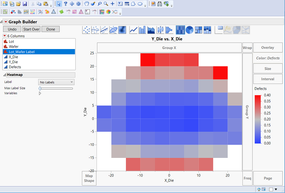What inspired this wish list request?
Heatmaps are great to display variations of a value depending on 2 input variables.
prominent use case: measured values vs. x/y position (e.g. chips on a wafer)
Unfortunately, Heatmaps use the minor Tick spacing to determine the size of the individual "tiles".
This leads to a which actually feels like a bug for many Jmp users - the issue:
The tick settings (and with them: the Heatmap tile size!) are automatically adjusted whenever the user changes the axis range by dragging the axis or by zooming with the magnifier tool:
Some problem using Heatmap
Concerning axis adjustments by dragging, @julian 's suggestion helps: hold down SHift while changing the axis scaling.
But it just helps when you drag one end of the axis - if you want to zoom out by grabbing the axis and moving it away from the plot, you will ruin you plot - with and without pressing Shift. Same issue with the magnifier tool:
https://community.jmp.com/t5/Discussions/Some-problem-using-Heatmap/m-p/571751/highlight/true#M78136
What is the improvement you would like to see?
An option for GraphBuilder/Heatmap to forces JMP to set the tick spacing fixed.
This will allow users to keep the tick spacing exactly as it was defined by the user.
Why is this idea important?
Under the line: tiny change of the program - tremendous improvement for the users.
maybe there are some users who don't need it - or: some users who don't know yet that they need it :)
No longer destroyed plots after adjusting the axis range/zoom :)
- most important use case: "1x1"
(for chip wafer maps in Semiconductor Industry)
error 1) Jmp clusters multiple chips into one cell by increasing minot tick step size to > 0 -> individual outliers get averaged out!

error 2) Jmp invents empty "sub-Chips" by automatically changing minor tick step size to < 1:

To be on the safe side, cautious users abandon the Heatmap style and plot wafermaps as Points:
either with mainly white area around the "points" - which makes it hard to get the actual info:

or with overlapping points -> dangerous, almost as bad as the clustering issue (#1) (!)
